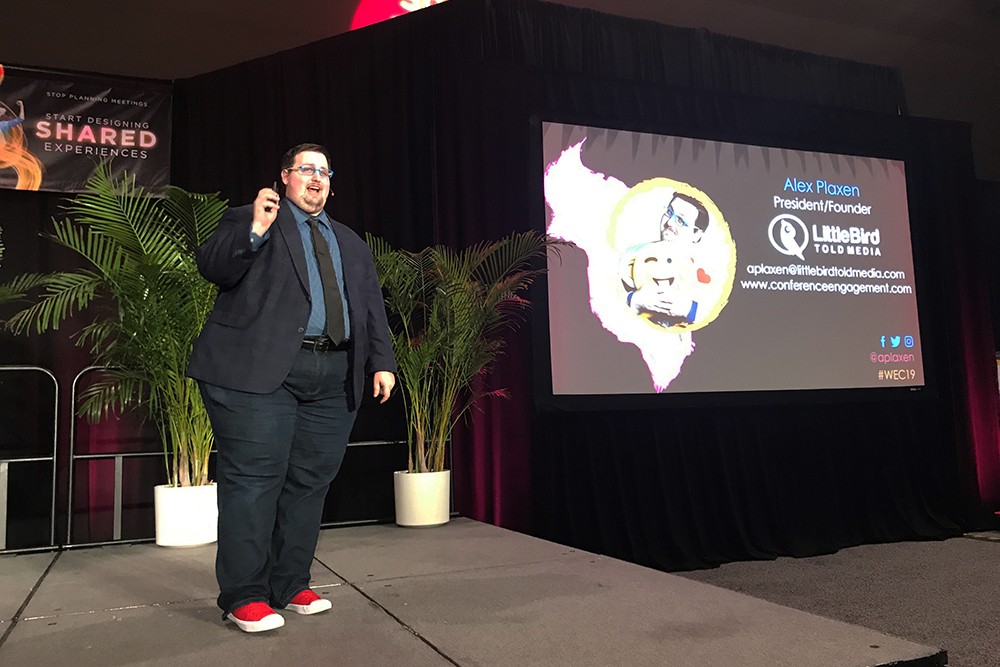It’s easy for meeting planners and their teams to get lost in a sea of analytics numbers reported across multiple social media platforms.
At MPI World Education Congress 2019, Alex Plaxen, president and founder of Little Bird Told Media, helped attendees focus on which social media analytics really matter to the strategic success of their organizations.
He offered “SMART Goals” as a simple formula to measure social media objectives. Goals should be:
- Specific
- Measurable
- Attainable
- Relevant
- Timely
“Match your goals to your objective,” Plaxen said during his presentation, The Real ROI of Social Media. “And if it’s not in a time frame, you won’t be able to do it. It’s all about putting a 'number of increase' and a time frame on it.”
“It’s not ‘We will have [x number] of Facebook Live viewers,'” he explained. “It’s increase Facebook Live viewers by 25% by two months before the event.'”
A similar focus also applies to increasing web traffic, such as increasing blog views by 25% in two weeks, Plaxen noted.
1. Define Your Social Media Objectives and Goals
Plaxen offered a basic example of social media objectives (what) and goals (how and when) for meetings and events planners to consider:
- Business Conversions: Provide our sales team with high-quality leads through social media.
Example Goal: Drive 30 email sign-ups per month. - Brand Awareness: Increase awareness of our event before registration opens and take attention away from our competitors.
Example Goal: Boost our social share of voice by 30% by the end of the quarter. - Attendee Experience: Turn our attendees into loyal brand advocates by improving customer service.
Example Goal: Reduce average response time on social to one hour by September 1. - Security and Risk Mitigation: Protect our attendees and organization from threats on social media.
Example Goal: Increase detection speed of potential social media PR crises by 20% by the end of the year.
Focusing on exactly which numbers to measure during a social media audit is as important as having robust analytics across all active social media platforms, according to Plaxen.
“Go through all your social media accounts and identify KPIs [key performance indicators],” he said.
But Plaxen cautioned attendees not to focus on every single measurement because not all are relevant to your goals and objectives.
“This is going to be the foundation of everything you create,” he added.
[Related Content: Social Media Seizes the Event Marketing Spotlight]
Plaxen recommended that all handles should be consistent across all platforms, and attendees should examine consistencies in top performing posts.
Do top performers all use graphics? Do they use active instead of passive verbs? It is also key to have different strategies for each social media platform.
“If you have the same strategy for each one, you’re doing it wrong,” Plaxen said. “You should have a different mission statement for each account.
“A couple [strategies] can be the same, but they should not all be the same,” he added.
2. Create a Social Media Audit Document
Creating a strategic social media audit document can help meeting and event planners ensure their social media presence is consistent and ready for engagements.
Plaxen offered the following tips for starting the document:
- Link to your social profiles from your website and event landing page.
- Include your social handles on all event materials.
- Ensure all handles are consistent.
- Dedicate an internal person or team who manages the account.
- Create a mission statement for the account.
- List the top three posts in terms of engagement.
- Include three important metrics (KPIs).
- Include key demographic information.
- Ensure profile and cover photos are up to date.
- Update profiles and bios as necessary.
- Check that any pinned posts are still relevant.
3. Choose the Proper Metrics
Plaxen suggested drafting a mission statement for each channel as a start to identifying relevant metrics. A successful mission statement should include:
- Awareness: These metrics illuminate your content and potential audience, including brand awareness, audience growth rate, post reach, potential reach and social share of voice.
- Engagement: These metrics show how audiences are interacting with your content and can include applause rate (such as “likes”), average engagement rate, amplification and virality.
- Conversion: These metrics demonstrate the effectiveness of your social engagement. Consider measuring conversion rate, click-through rate, cost-per-click, cost per thousand impressions and social media conversion rate.
- Consumer: These metrics reflect how active customers think and feel about your brand. Examples include customer testimonials, customer satisfaction score and net promoter score.
Finally, meeting and event planners should evaluate the performance of their social media channels in relation to their individual mission statements. During regular reviews, planners should choose one or two key metrics and note their performance to determine whether the account performs well based on the metrics outlined in the mission statement.
4. Develop Your Metrics Strategy
Once metrics are selected, you can develop your strategy for analyzing and reporting on metrics. With every metrics review, ask yourself:
- Does it align with my objectives?
- Does it help me make decisions?
- Can I measure it effectively?
“If it doesn’t help you make decisions, why are you measuring it?” Plaxen stressed.
He added that having a large number of followers isn’t necessarily a successful strategy, as followers can be easily added through bots and then disappear soon after.
“It’s not the numbers that matter, it’s if they actually care about your organization and will engage you,” he said. “You need to understand your audience.
“You don’t have to be on every platform if they’re not, and if you’re struggling with one platform, maybe it’s not the right one for you,” Plaxen concluded.
[Read This Next: 3 Trends to Watch From IACC's Meeting Room of the Future Report]







